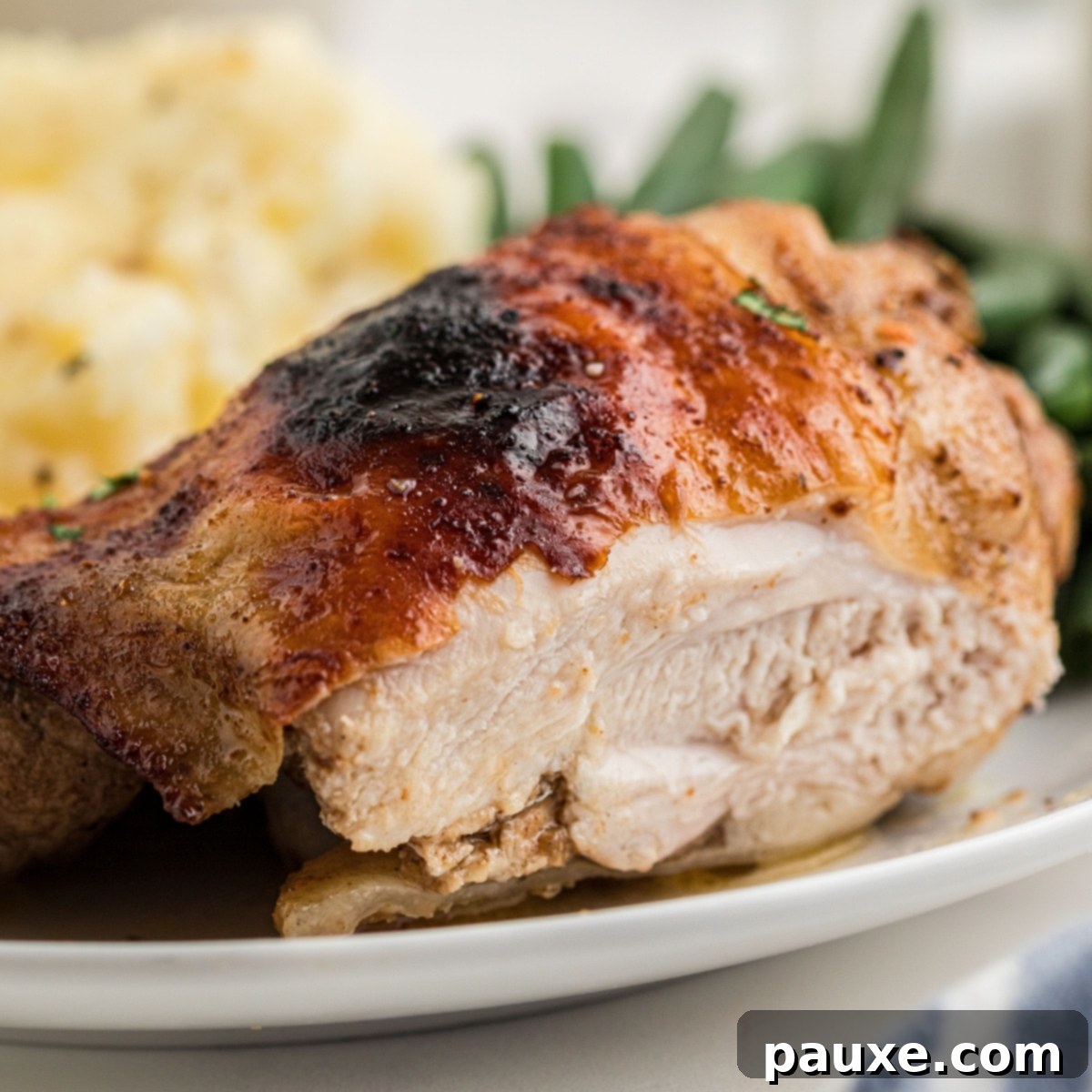The Best All-Purpose Chicken Marinade Recipe for Flavorful & Juicy Chicken
Unlock the secret to consistently delicious and tender chicken with this incredibly easy chicken marinade recipe. Crafted from simple, everyday ingredients like olive oil, Worcestershire sauce, and a thoughtful blend of seasonings, this marinade guarantees an explosion of flavor and unparalleled juiciness every single time. Whether you’re a seasoned chef or a beginner in the kitchen, this all-purpose marinade will elevate your chicken dishes to new heights, making it a staple in your culinary repertoire.
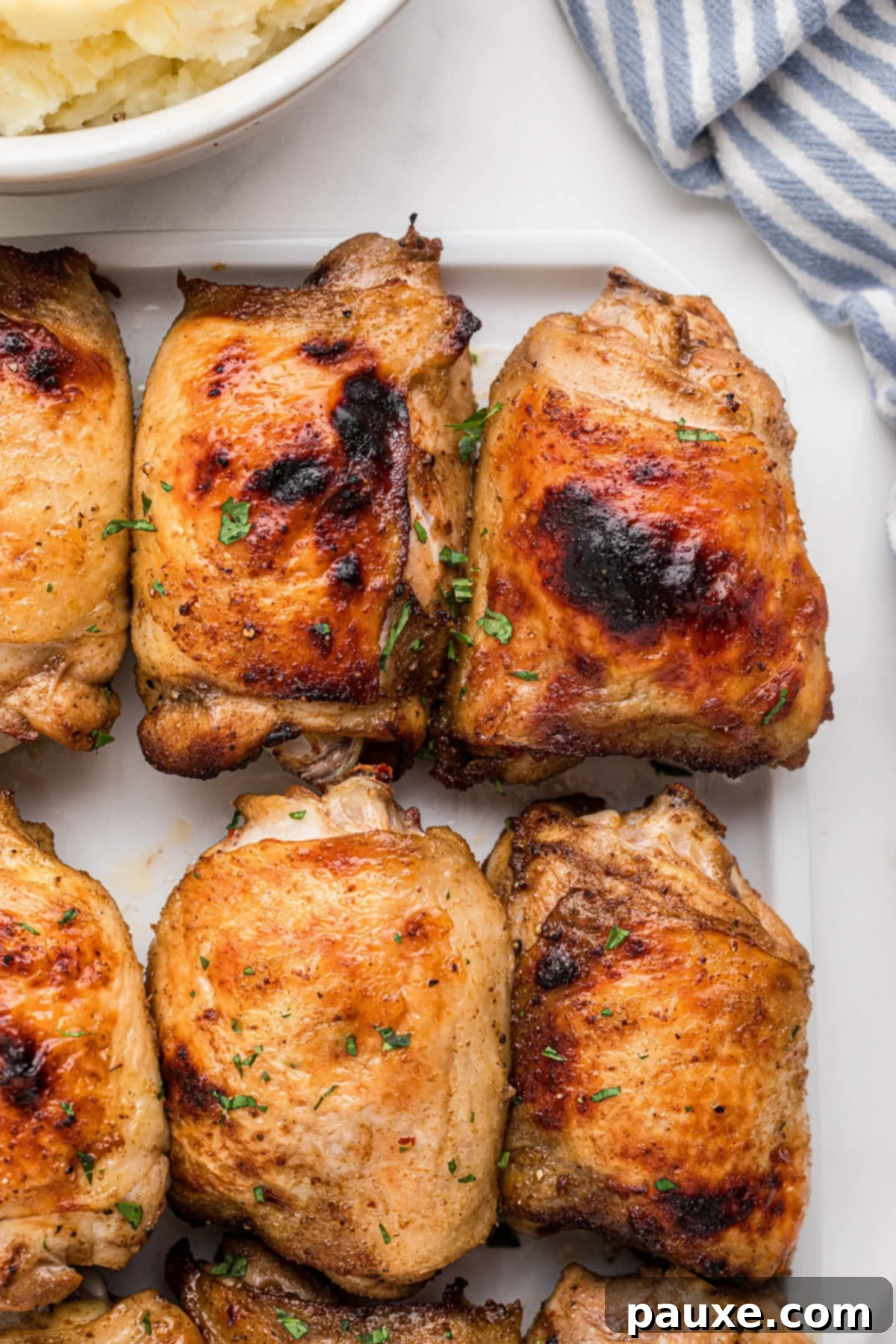
Are you endlessly searching for the best chicken marinade recipe that truly delivers? Your quest ends here! This versatile and flavorful marinade is designed to transform ordinary chicken into an extraordinary meal, suitable for any cooking method you prefer.
Not only is it the ultimate way to infuse your favorite cuts of chicken with incredible flavor and moisture, but its balanced profile also makes it remarkably effective for marinating a wide array of other protein options. From preparing your meat the day before for effortless weeknight dinners to adding a quick burst of flavor just moments before grilling, baking, or air frying, this simple yet powerful marinade is your perfect culinary companion.
Marinating is a foundational technique that helps tenderize meat, enhance its flavor, and keep it moist during cooking. Our special blend ensures that every bite of your chicken will be succulent, savory, and bursting with a harmonious mix of sweet, tangy, and umami notes. Say goodbye to dry, bland chicken and hello to perfectly seasoned, melt-in-your-mouth meals!
Why Marinate Your Chicken? The Science of Flavor
Marinating chicken isn’t just about adding flavor to the surface; it’s a scientific process that significantly improves the taste, texture, and moisture content of your meat. Here’s a closer look at what makes a good marinade effective:
- Tenderization: Acids like apple cider vinegar work to break down the tough muscle fibers in chicken, resulting in a more tender and pleasant texture. This is particularly beneficial for leaner cuts like chicken breasts.
- Flavor Infusion: The combination of oil, acid, salt, and spices penetrates the surface of the meat, carrying delicious flavors deep into the chicken, rather than just coating the exterior.
- Moisture Retention: Oil helps to lock in moisture, preventing the chicken from drying out during cooking, especially at higher temperatures. Salt also plays a role in keeping the meat juicy by altering its protein structure to better hold water.
- Enhanced Browning: Sugars in the marinade (like brown sugar) caramelize during cooking, creating a beautiful golden-brown crust and adding another layer of complex flavor.
- Improved Texture: A well-balanced marinade can transform chicken, making it less chewy and more enjoyable to eat, regardless of the cooking method.
Versatility: What Can You Use This Marinade For?
This marinade is incredibly versatile and works wonders on a variety of proteins and cooking methods. Its balanced flavor profile makes it a true all-rounder in the kitchen.
- All Cuts of Chicken:
- Chicken breasts (boneless, skinless, or bone-in, skin-on)
- Chicken thighs (boneless, skinless, or bone-in, skin-on)
- Chicken wings or legs
- Chicken tenders
- Chicken bites/cubes for skewers or stir-fries
- Other Proteins:
- Pork (chops, tenderloin, ribs)
- Salmon fillets
- Shrimp (marinate for shorter periods, 15-30 minutes)
- Even as a fantastic steak marinade!
- Cooking Methods:
- Grilling for smoky, charred perfection
- Baking or roasting for hands-off cooking
- Air frying for crispy results with less oil
- Pan-searing for quick and easy weeknight meals
Essential Ingredients for the Perfect Chicken Marinade
Crafting the perfect marinade starts with a thoughtful selection of ingredients, each playing a crucial role in delivering flavor, moisture, and tenderness. This recipe calls for pantry staples that come together to create a harmonious blend.
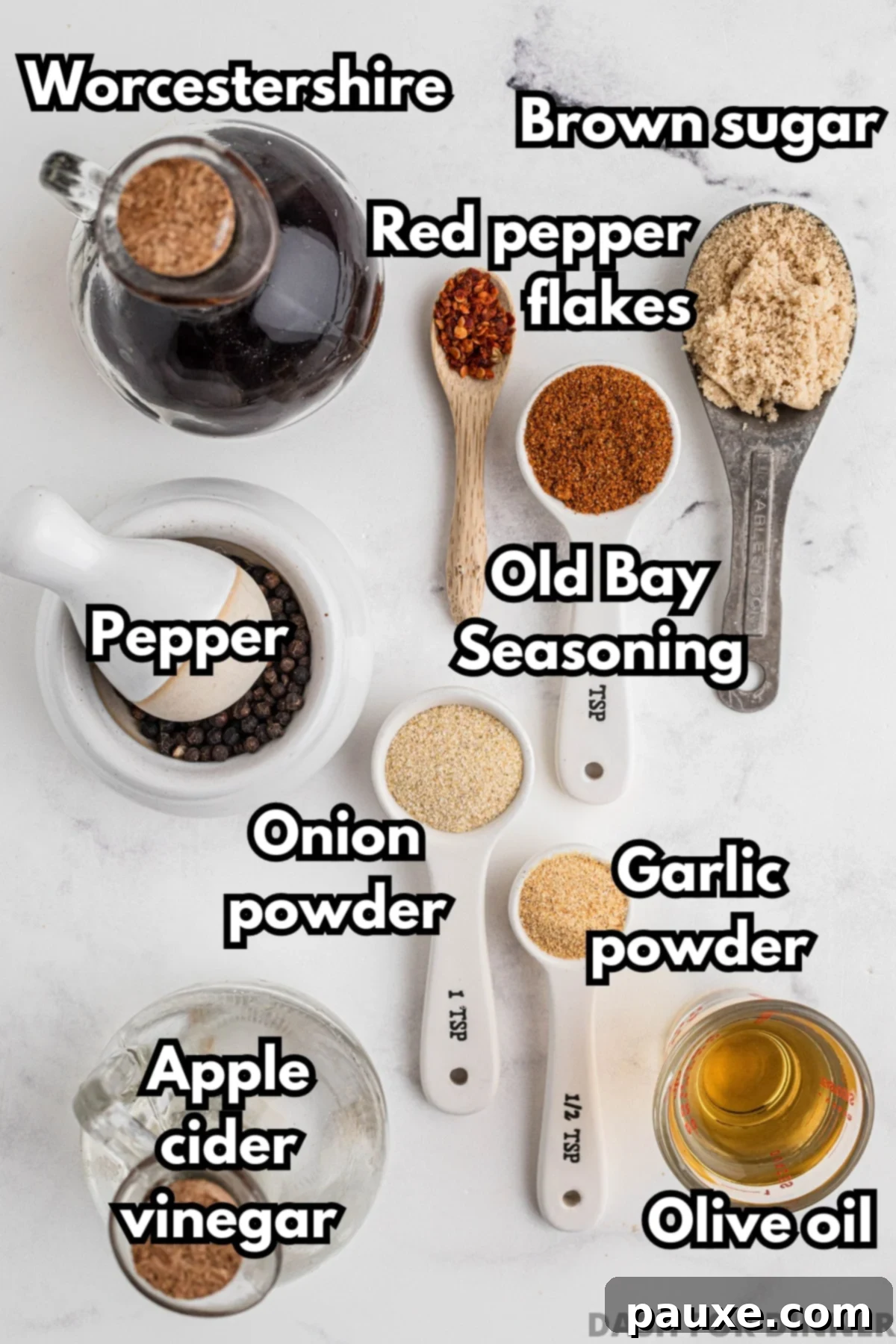
- Olive oil: The base of our marinade, olive oil helps distribute flavors evenly, prevents the chicken from sticking to cooking surfaces, and contributes to moisture retention. Use a good quality extra virgin olive oil for the best taste.
- Apple cider vinegar: This is our key acidic component. It tenderizes the chicken by breaking down muscle fibers and adds a tangy, slightly fruity note that brightens the overall flavor profile.
- Worcestershire sauce: A secret weapon for umami depth, Worcestershire sauce brings a rich, savory, and slightly tangy flavor that is characteristic of many classic marinades. It really makes the chicken sing!
- Brown sugar: Balances the acidity and savory notes with a touch of sweetness. Brown sugar also aids in caramelization during cooking, leading to that appealing golden-brown crust and enhanced flavor.
- Seasonings: A robust blend of spices ensures a well-rounded flavor.
- Onion powder: Provides a sweet and savory onion flavor without the texture.
- Garlic powder: Adds a foundational aromatic depth.
- Red pepper flakes: Offers a subtle kick of heat, which can be adjusted to your preference.
- Old Bay seasoning: A unique blend of spices (including celery salt, paprika, and other herbs) that brings a distinctive, savory, and slightly spicy note, particularly fantastic with chicken.
- Black pepper: A universal spice that adds warmth and a pungent aroma.
Essential Tools and Equipment
To make and cook your marinated chicken with ease, you’ll need a few basic kitchen tools:
- Freezer bag (or large bowl with lid): Ideal for mixing the marinade and ensuring even coating of the chicken. Freezer bags are great for less mess and easy massaging.
- Baking rack, grill, or air fryer: Your chosen cooking apparatus for perfectly cooked chicken.
- Tongs: Essential for handling raw chicken and flipping it during cooking.
- Meat thermometer: The most reliable way to ensure your chicken is cooked to a safe internal temperature, preventing overcooking and dryness.
For precise measurements and a full list of ingredients, always refer to the recipe card below.
How to Make the BEST Chicken Marinade & Marinate Your Chicken
Preparing this marinade is incredibly straightforward, requiring just a few minutes of active time. Follow these steps for perfectly marinated chicken:
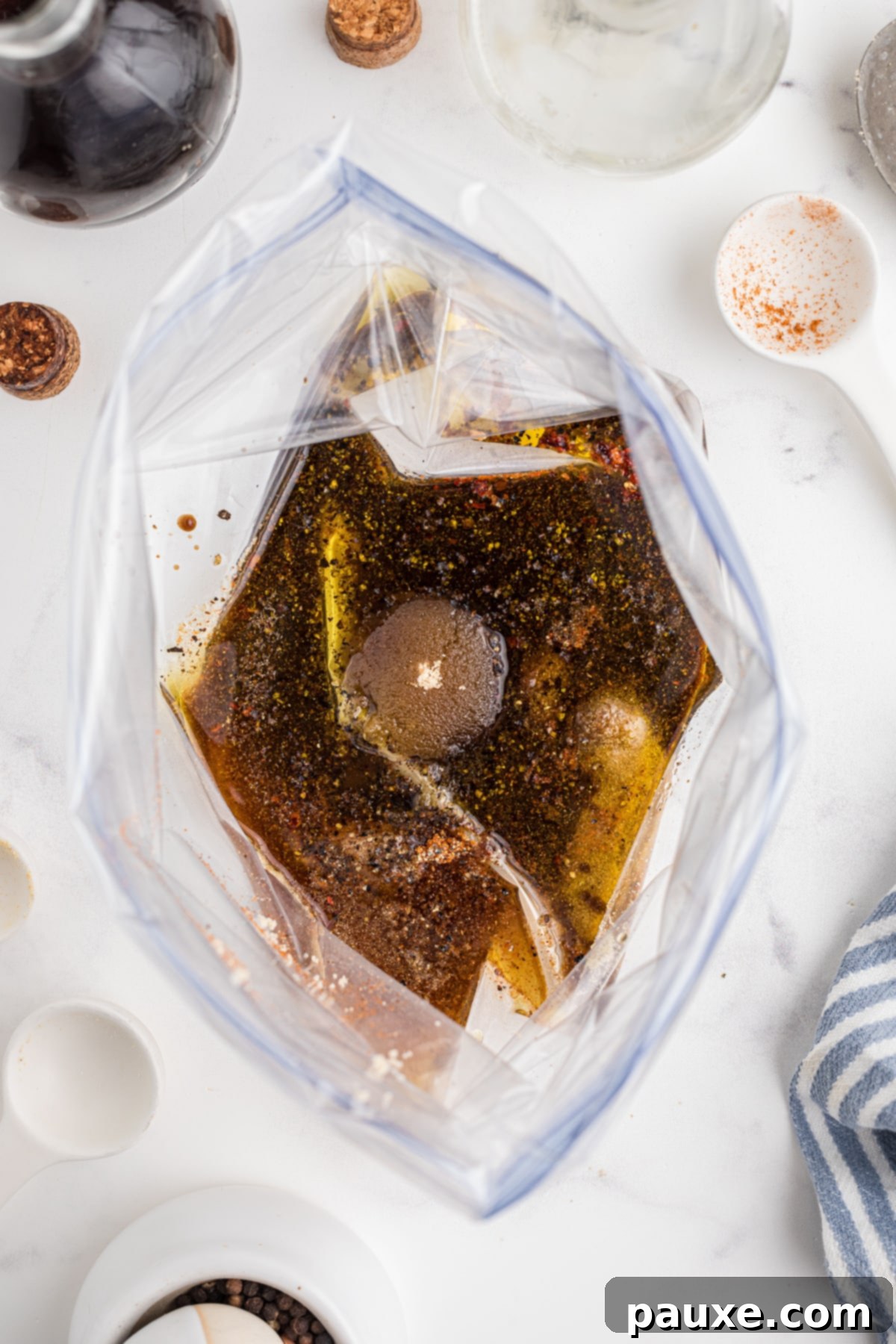
- Combine Ingredients: In a large zip-top bag (or a spacious bowl), add all the marinade ingredients: 5 tablespoons of olive oil, 2 tablespoons of apple cider vinegar, 2 tablespoons of Worcestershire sauce, 2 tablespoons of light brown sugar, 1 teaspoon of Old Bay seasoning, 1 teaspoon of onion powder, ½ teaspoon of garlic powder, and ½ teaspoon of red pepper flakes.
- Mix Thoroughly: Seal the bag (or cover the bowl) and mix vigorously until all the ingredients are well combined and the brown sugar has dissolved. This ensures an even distribution of flavors.
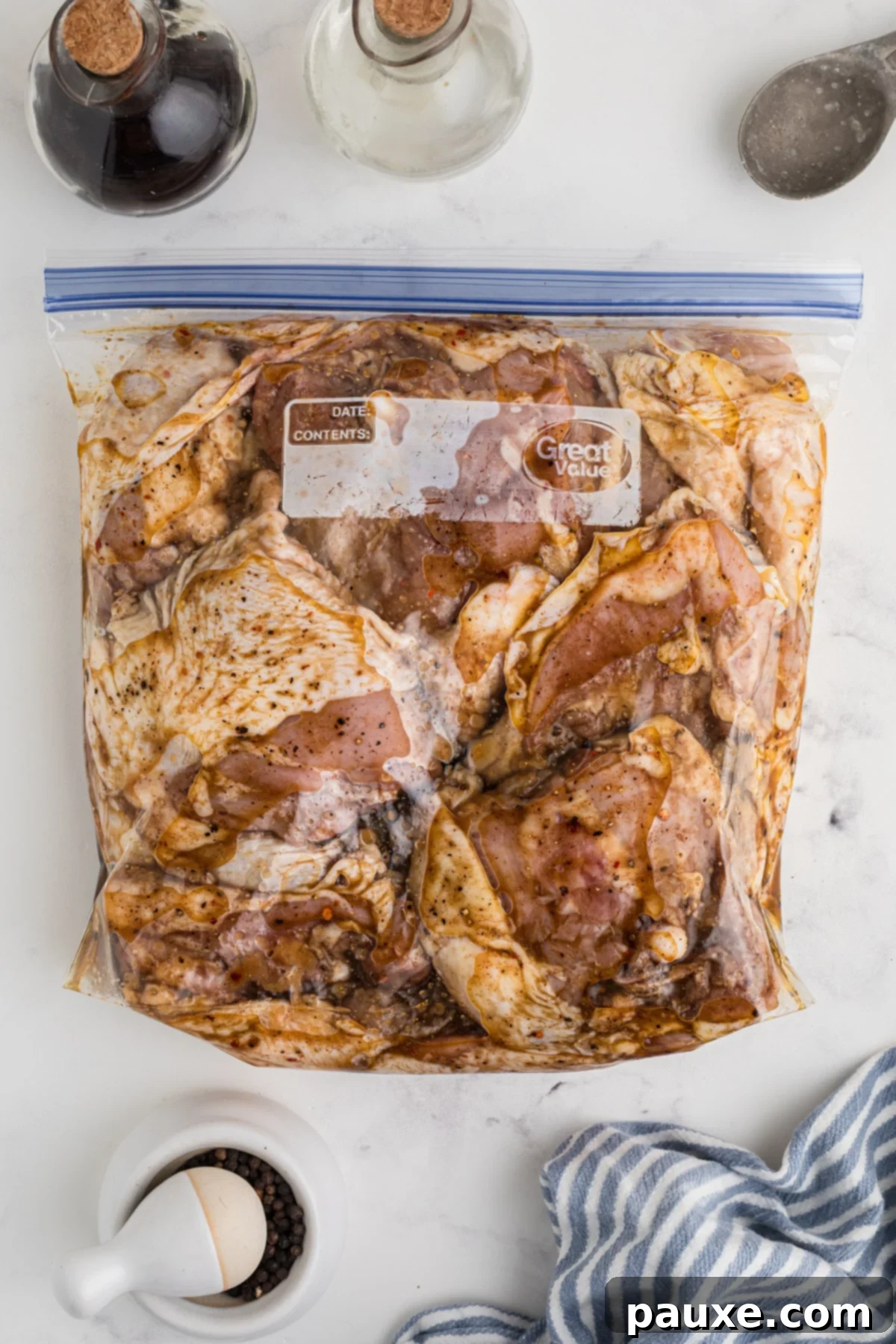
- Add Chicken: Carefully add 1-2 pounds of your preferred cut of chicken to the bag or bowl. If using a bag, seal it tightly, pressing out as much air as possible. If using a bowl, ensure it’s well covered.
- Massage and Coat: Use your hands to gently massage the marinade into the chicken, making sure every piece is thoroughly coated. This helps the flavors penetrate the meat more effectively. If using a bowl, stir well before covering.
- Marinate: Place the chicken in the refrigerator to marinate.
- For a quick flavor boost, marinate at room temperature for up to 90 minutes.
- For optimal flavor and tenderness, marinate in the refrigerator for at least 2 hours, and ideally up to 24 hours. Avoid marinating for longer than 48 hours, as the acid can start to break down the meat too much, leading to a mushy texture.
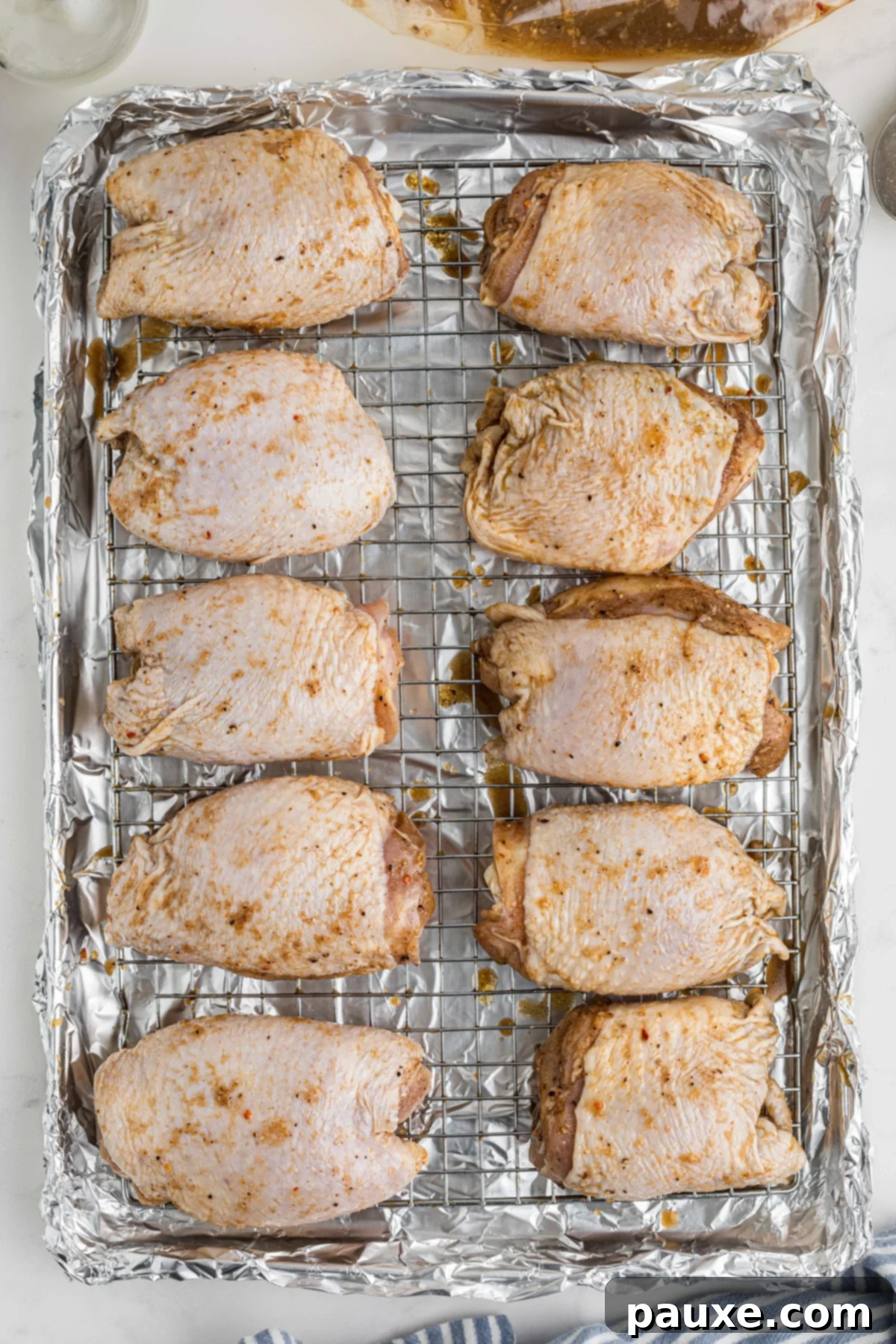
- Prepare for Cooking: Once marinated, remove the chicken from the bag or bowl, allowing any excess marinade to drip off. Discard the leftover marinade (unless you plan to boil it into a sauce, as described below). Preheat your chosen cooking appliance (oven, grill, or air fryer) according to the specific instructions for your preferred cooking method.
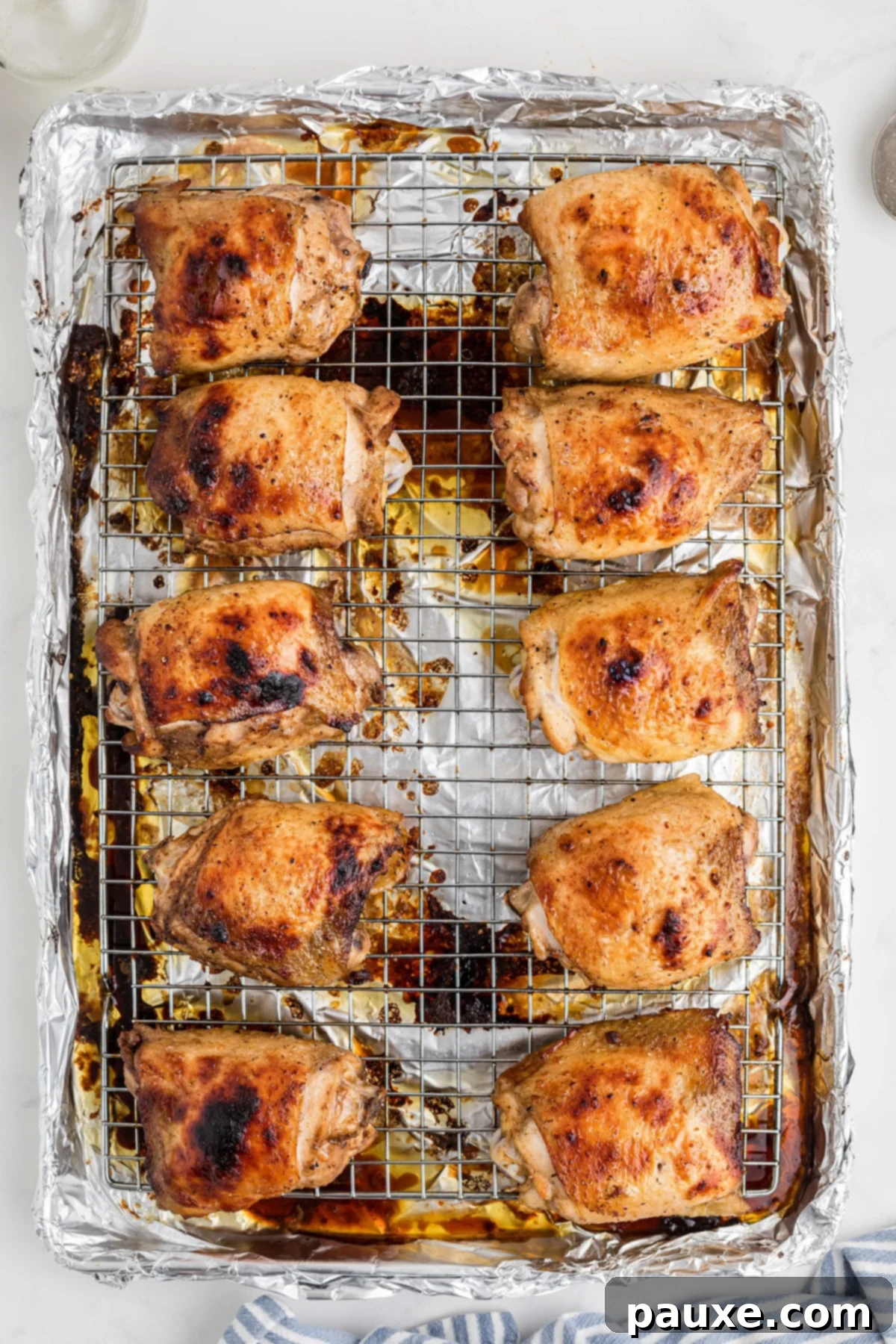
- Cook to Perfection: Cook the chicken using your desired method until each piece reaches a minimum internal temperature of 165ºF (74ºC) at its thickest part. Always use a meat thermometer for accuracy. After cooking, allow the chicken to rest for 5-10 minutes before slicing and serving. This resting period allows the juices to redistribute throughout the meat, resulting in a more tender and flavorful outcome.
Detailed cooking instructions and approximate times for various methods are provided in the section below.
Ways to Cook Your Perfectly Marinated Chicken
This marinade is designed to excel with a variety of cooking methods, ensuring tender and flavorful results every time. Here’s how to cook your marinated chicken to perfection:
- Baked or Roasted Chicken: For a hands-off approach that yields consistently juicy results, baking is a fantastic option.
- Preheat your oven to 425ºF (220ºC).
- Line a baking sheet with foil for easy cleanup, then place a wire baking rack on top (this promotes even browning by allowing air circulation).
- Arrange the marinated chicken pieces in a single layer on the rack, ensuring they are not overcrowded.
- Bake until the chicken reaches a minimum internal temperature of 165ºF (74ºC). Cooking times will vary based on the cut and thickness:
- Chicken thighs, bone-in, skin-on: Approximately 35 minutes.
- Chicken breasts, boneless and skinless: 19-25 minutes, depending on size.
- Chicken breasts, bone-in, skin-on: 35-45 minutes.
- Chicken thighs, boneless and skinless: 20-30 minutes.
- Chicken tenders: 15-22 minutes.
- Once cooked, remove from the oven and let the chicken rest for about 5 minutes. For dark meat cuts like thighs, this resting period often allows the internal temperature to rise to a perfect 170ºF (77ºC), ensuring maximum tenderness.
- Grilled Chicken: Achieve that wonderful smoky flavor and beautiful char marks with grilling.
- Preheat a propane or charcoal grill to medium-high heat. Lightly oil the grates to prevent sticking.
- Place the marinated chicken pieces on the hot surface. Close the lid if applicable.
- Cook for 5-7 minutes per side, or until the chicken reaches a minimum internal temperature of 165ºF (74ºC). Adjust cooking time as needed for thicker cuts.
- Remove the chicken from the grill and let it rest for 5 minutes before serving. This allows the juices to redistribute, keeping the chicken moist.
- Air Fryer Chicken: For a quick, crispy, and healthier option, the air fryer is excellent.
- Preheat your air fryer to 390ºF (199ºC).
- Place 3-4 pieces of marinated chicken in the air fryer basket at a time, ensuring not to overcrowd it. Cook in batches if necessary for even cooking.
- Air fry until each piece meets an internal temperature of 165ºF (74ºC). Approximate cooking times:
- Chicken thighs: 12-14 minutes.
- Chicken breasts: 12-16 minutes, flipping halfway through.
- Chicken wings: 10-13 minutes.
- Chicken tenders: 6-10 minutes, flipping halfway through.
- Once cooked, remove from the air fryer and let it rest for 5 minutes before serving.
What Can I Do With Leftover Marinade? (Making a Glaze or Sauce)
While raw marinade should never be reused directly due to potential bacterial contamination from raw meat, you can safely transform it into a delicious glaze or sauce!
- Transfer to Saucepan: Pour the excess marinade (the liquid that was in contact with the raw chicken) into a small saucepan.
- Thin and Boil: Add about ½ – ¾ cup of water or chicken broth to thin the sauce slightly. Bring the mixture to a rolling boil over medium-high heat.
- Cook Thoroughly: Once it reaches a minimum temperature of 165ºF (74ºC), maintain this heat for at least 2 minutes to ensure all bacteria are killed. Stir frequently to prevent scorching.
- Reduce and Thicken: Reduce the heat to low and allow the sauce to simmer gently. Continue to cook, stirring occasionally, until it reduces to your desired consistency – whether you prefer a thin glaze or a thicker sauce.
- Serve: Spoon the freshly made glaze or sauce over your cooked chicken for an extra layer of savory, tangy, and slightly sweet flavor.
Important Note: It is absolutely crucial to bring the marinade to a full rolling boil and maintain it at 165ºF (74ºC) for a minimum of two minutes to eliminate any bacteria from the raw chicken. If you don’t plan to cook the marinade into a sauce, it should always be discarded after use with raw meat. Food safety is paramount!
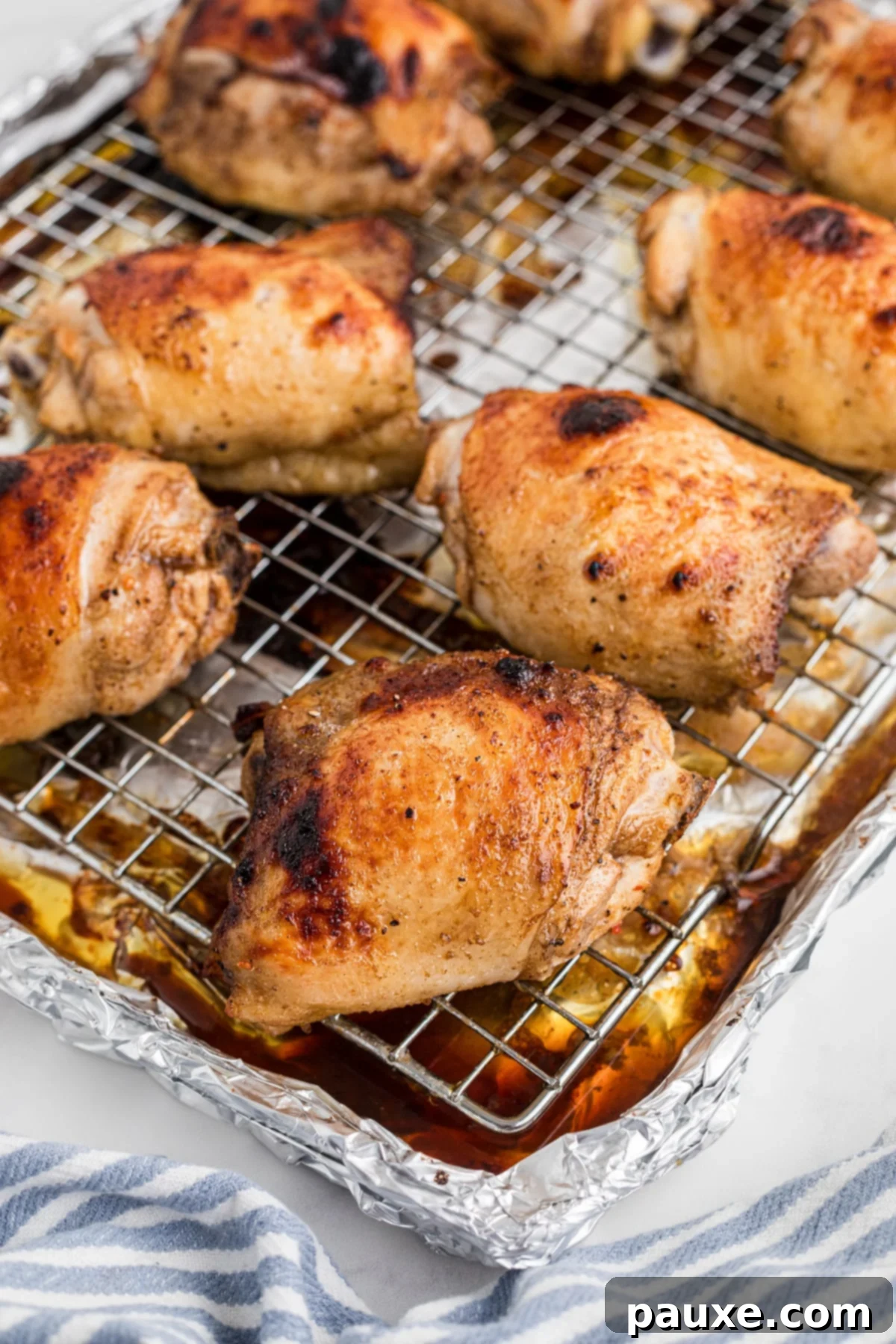
Clever Substitutions & Flavor Variations
This marinade recipe is incredibly adaptable, allowing you to customize it based on your pantry, dietary needs, or flavor preferences. Don’t be afraid to experiment!
- Acidic Ingredient: While apple cider vinegar provides a lovely tang, you can easily swap it for other acidic liquids.
- Try white vinegar, red wine vinegar, or balsamic vinegar for different flavor notes.
- Fresh citrus juice, such as orange, lemon, or lime juice, adds a vibrant, zesty twist.
- Savory Element: Worcestershire sauce delivers deep umami, but other savory options work well.
- Soy sauce or tamari (for gluten-free) offers a salty, Asian-inspired depth.
- Coconut aminos are a great soy-free and gluten-free alternative.
- Fish sauce can add an intense, funky umami kick (use sparingly).
- Oyster sauce provides a thicker, slightly sweeter savory profile.
- Spice and Herb Variations: The dried seasonings are fantastic, but feel free to incorporate fresh herbs for a brighter flavor.
- My favorite fresh herbs for chicken include rosemary, thyme, sage, and tarragon. Finely chop about 1-2 tablespoons of fresh herbs per batch.
- For a spicier kick, increase the red pepper flakes or add a pinch of cayenne pepper.
- Experiment with other spice blends like paprika, cumin, chili powder, or Italian seasoning.
- Dijon Mustard: For an extra layer of pungency and emulsifying power, a teaspoon or two of Dijon mustard can be a wonderful addition, especially if you enjoy its sharp, tangy flavor.
- Alternative Meats: Although developed for chicken, the robust flavors of this marinade are suitable for a variety of proteins.
- Pork chops, tenderloin, or even tougher cuts for slow cooking.
- Salmon fillets and shrimp (reduce marinating time for seafood to 15-30 minutes).
- Tofu or tempeh for a vegetarian option (press firm tofu before marinating).
- Cooking Oil: Extra virgin olive oil is a great choice, but any high-heat, neutral-flavored oil will work just as well.
- Avocado oil, vegetable oil, canola oil, or peanut oil are all excellent substitutes.
What if I Don’t Have Old Bay Seasoning?
Old Bay seasoning is a wonderfully unique blend that brings a distinct, savory, and slightly spicy flavor, making it a fantastic staple for your spice drawer. It pairs beautifully with all kinds of dishes, but is particularly renowned for its magic with seafood like shrimp, salmon, and crab, as well as poultry.
If you don’t have Old Bay on hand, don’t worry! You have a couple of options:
- Homemade Old Bay Substitute: If you have a well-stocked spice cabinet, you can easily create your own blend. A common homemade Old Bay seasoning recipe typically includes a combination of celery salt, paprika, black pepper, cayenne pepper, mustard powder, ground mace, cinnamon, cardamom, and ginger. You can find many recipes online, such as this one from Daring Gourmet’s homemade Old Bay seasoning recipe.
- Simplified Substitute: For a simpler approach, focus on the key flavor notes. Combine a pinch of celery seed, a dash of paprika, a touch of white pepper, and a small amount of dried mustard powder and salt. While it won’t be an exact match, it will provide a similar aromatic profile.
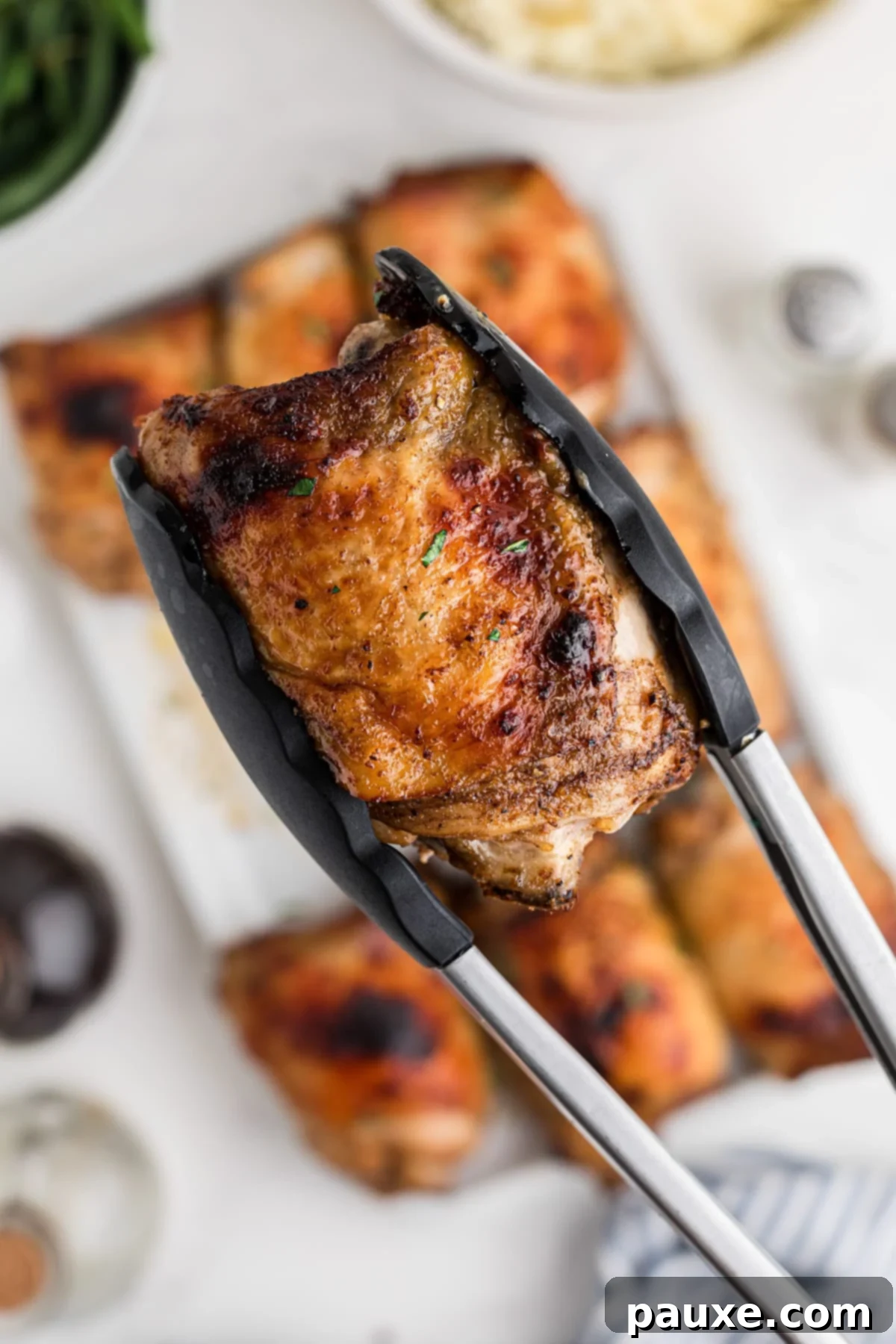
Can I Prepare the Marinade in Advance? (Meal Prep Friendly)
Absolutely! This marinade is an excellent candidate for meal prepping, allowing you to save time and effort on busy cooking days. Preparing it in advance is simple and convenient.
- Marinade Alone: You can prepare the marinade mixture itself up to 3 days ahead of time. Store it in an airtight container or a sealed zip-top bag in the refrigerator. This allows the flavors to meld and deepen even further.
- Marinade with Meat: Only add the chicken (or other meats) to the marinade if you intend to cook the meat within the next 24 hours. For best results and food safety, avoid prolonged marinating beyond 24 hours in the refrigerator, as the acid can begin to break down the meat too much.
Freezing Marinated Chicken
This recipe is perfect for freezer-friendly meal prep! You can marinate and freeze chicken for future convenience:
- Prepare and Freeze: Prepare the marinade as directed. Add the chicken (or your desired protein) to a freezer-safe zip-top bag with the marinade. Ensure the chicken is thoroughly coated.
- Label and Store: Label the bag with the date and contents. Freeze until solid. Marinated chicken can be stored in the freezer for up to 3 months.
- Thawing: When you’re ready to cook, thaw the frozen marinated chicken slowly. Transfer the freezer bag to a baking pan or a large bowl in the refrigerator 1-2 days before you plan on cooking. This slow thawing process helps maintain texture and flavor.
- Cook and Enjoy: Once thawed, remove the chicken from the marinade (discarding any leftover liquid), and cook as desired using your preferred method (baking, grilling, or air frying).
Recipe FAQs (Frequently Asked Questions)
How long should you marinate chicken?
The ideal window for marinating chicken is typically between 2 to 12 hours. This duration allows enough time for the flavors to deeply penetrate the meat and for the acid to tenderize it without compromising the texture.
If you’re short on time, even a quick 15-20 minute marinade will impart some flavor, especially if the chicken is thinly sliced or cut into smaller pieces. For maximum flavor and tenderness, marinating for 4-8 hours is often considered optimal.
It’s generally safe to marinate chicken in the refrigerator for up to 24 hours. However, be cautious not to exceed 48 hours, as the USDA advises. Beyond this, the acid in the marinade can start to break down the meat’s proteins too much, potentially leading to a mushy or mealy texture.
Source: How long can meat and poultry be marinated? – USDA
What can I use instead of Old Bay seasoning?
If Old Bay seasoning isn’t a pantry staple for you, don’t let that stop you from making this delicious marinade. You have a couple of excellent alternatives:
- Homemade Blend: The best substitute is often a homemade blend. A typical Old Bay-like mix includes crushed bay leaves, celery seed, paprika, ground dry mustard, ginger, white pepper, and salt. Adjust the ratios to your taste.
- Simple Spice Combination: For a quick fix, combine a pinch of celery seed, a dash of paprika, and a small amount of garlic powder and onion powder. While it won’t be identical, it will provide a similar aromatic and savory profile that complements the other marinade ingredients well.
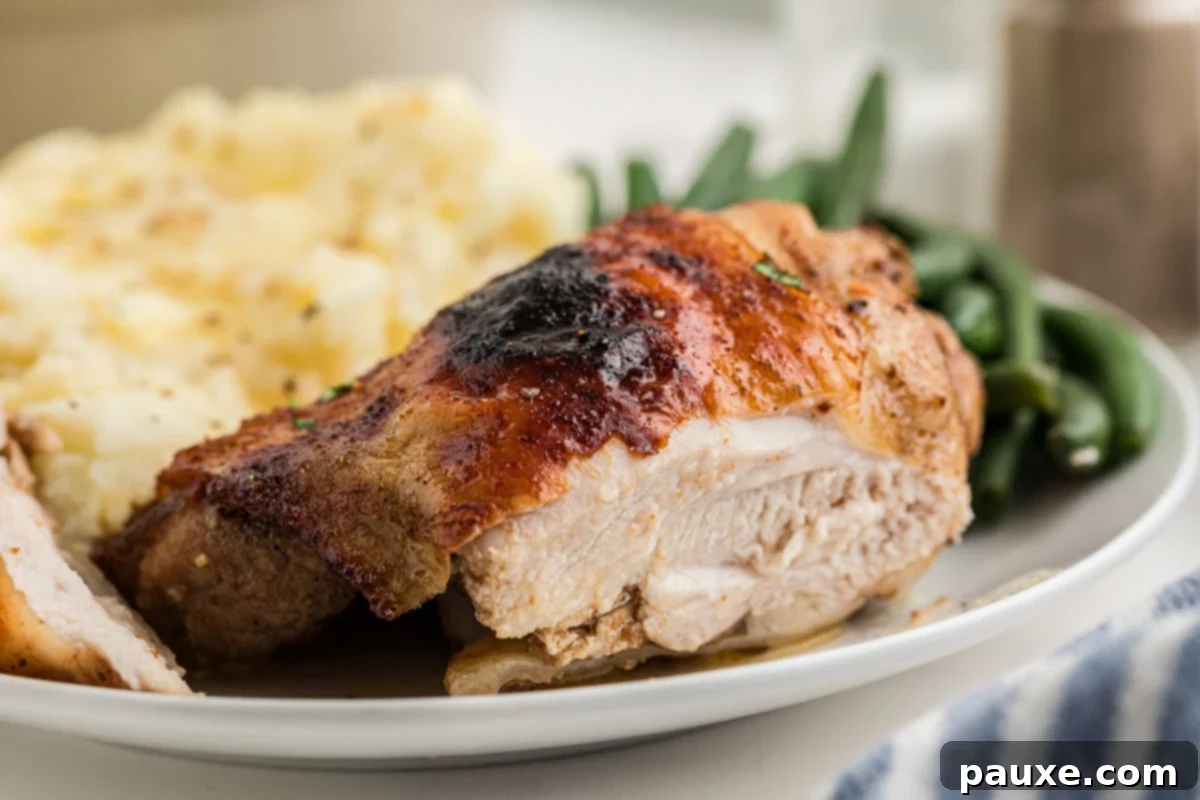
Serving Suggestions for Your Marinated Chicken
Once your perfectly marinated and cooked chicken is ready, it’s time to create a complete meal! This versatile chicken pairs beautifully with a wide array of side dishes. Here are some ideas to inspire your plate:
- Classic Sides:
- Creamy mashed potatoes or fluffy rice (white or brown).
- Steamed or roasted vegetables like broccoli, asparagus, green beans, or carrots.
- A fresh garden salad with a light vinaigrette.
- Heartier Options:
- Roasted root vegetables such as sweet potatoes, parsnips, or potatoes wedges.
- Quinoa, couscous, or farro for a wholesome grain side.
- Pasta salad or potato salad, especially great for a picnic or BBQ.
- Bread & Grains:
- Warm crusty bread or garlic bread to soak up any delicious juices.
- Corn on the cob or cornbread for a comforting touch.
- Creative Meals:
- Slice the chicken and add it to wraps, sandwiches, or quesadillas.
- Chop it up for a flavorful chicken salad.
- Serve over a bed of greens for a hearty, healthy salad.
- Incorporate into stir-fries or fajitas for a quick weeknight dinner.
No matter how you choose to serve it, this marinated chicken is sure to be a crowd-pleaser!
If you loved this easy recipe for chicken marinade, please consider leaving a 5-star review in the recipe card below or sharing your feedback in the comments section! Your ratings and comments help others discover and enjoy this recipe. You can also tag me on Instagram @dashfordinner to share your delicious creations.
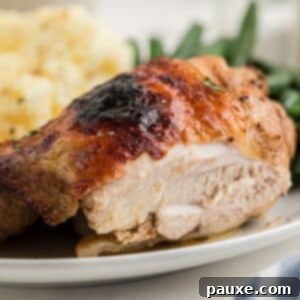
Chicken Marinade (for Grilling, Baking, or Air Frying)
This easy chicken marinade recipe is the best way to get flavorful and juicy chicken every single time! It works perfectly for ANY cooking method or cut of chicken, making it your go-to for delicious meals.
Course: Condiments, Sauces
Cuisine: American
Prep Time: 5 minutes
Total Time: 5 minutes (plus marinating time)
Servings: 6 servings (for 1-2 lbs of chicken)
Calories: 127 kcal (marinade only, not including chicken)
Author: Dorothy Bigelow
Print Recipe | Pin Recipe
Ingredients
- 5 tablespoons olive oil
- 2 tablespoons apple cider vinegar
- 2 tablespoons Worcestershire sauce
- 2 tablespoons light brown sugar
- 1 teaspoon Old Bay seasoning*
- 1 teaspoon onion powder
- ½ teaspoon garlic powder
- ½ teaspoon red pepper flakes
Instructions
- Add all of the marinade ingredients to a large bowl or zip-top freezer bag.
- Mix well to combine thoroughly.
- Add 1-2 pounds of chicken (or meat of your choice**), and massage the marinade into the meat, ensuring all pieces are well coated.
- Marinate for a minimum of 30 minutes up to 24 hours in the refrigerator. For quick marinating at room temperature, do not exceed 90 minutes.
- Remove the chicken from the leftover marinade, allowing excess to drip off. Discard the used marinade. Preheat your preferred cooking method (oven, grill, air fryer, etc.).
- Cook chicken as desired, ensuring it reaches an internal temperature of 165ºF (74ºC).***
Notes
- *Old Bay Substitute: If you don’t have Old Bay seasoning on hand, you can make homemade Old Bay seasoning, or use a combination of key ingredients like crushed bay leaves, celery seed, paprika, ground dry mustard, ginger, white pepper, and salt.
- **What can I use this marinade for? This marinade is incredibly versatile! It works well for all cuts of chicken, pork, salmon, and can be used for grilling, baking, or air frying.
- ***How to cook chicken: For detailed instructions on various cooking methods (oven, air fryer, grill) and specific cooking times, please refer to the “Ways to Cook Marinated Chicken” section of the article or the full recipe URL: https://dashfordinner.com/chicken-marinade/.
- Freezing: Prepare the marinade and add the protein of your choice to a freezer-safe bag. Label and freeze for up to 3 months. Thaw completely in the refrigerator before cooking as desired.
- Nutritional Information Disclaimer: Please note that the nutritional information provided below calculates the marinade “as is” and does not account for the chicken itself. The meat will absorb only a small fraction of the marinade’s caloric and nutritional value. Therefore, it is challenging to provide precise nutritional data for the final cooked product after the leftover marinade is discarded.
Nutrition (Marinade per serving, approximate)
- Calories: 127 kcal
- Carbohydrates: 6g
- Protein: 0.1g
- Fat: 12g
- Saturated Fat: 2g
- Polyunsaturated Fat: 1g
- Monounsaturated Fat: 9g
- Sodium: 78mg
- Potassium: 66mg
- Fiber: 0.2g
- Sugar: 5g
- Vitamin A: 63IU
- Vitamin C: 1mg
- Calcium: 15mg
- Iron: 1mg
Please note that some of my blog posts here at Dash for Dinner may contain affiliate links. If you make a purchase through these links, I will get a small commission at no additional cost to you. Please see my Disclaimer for more information.
